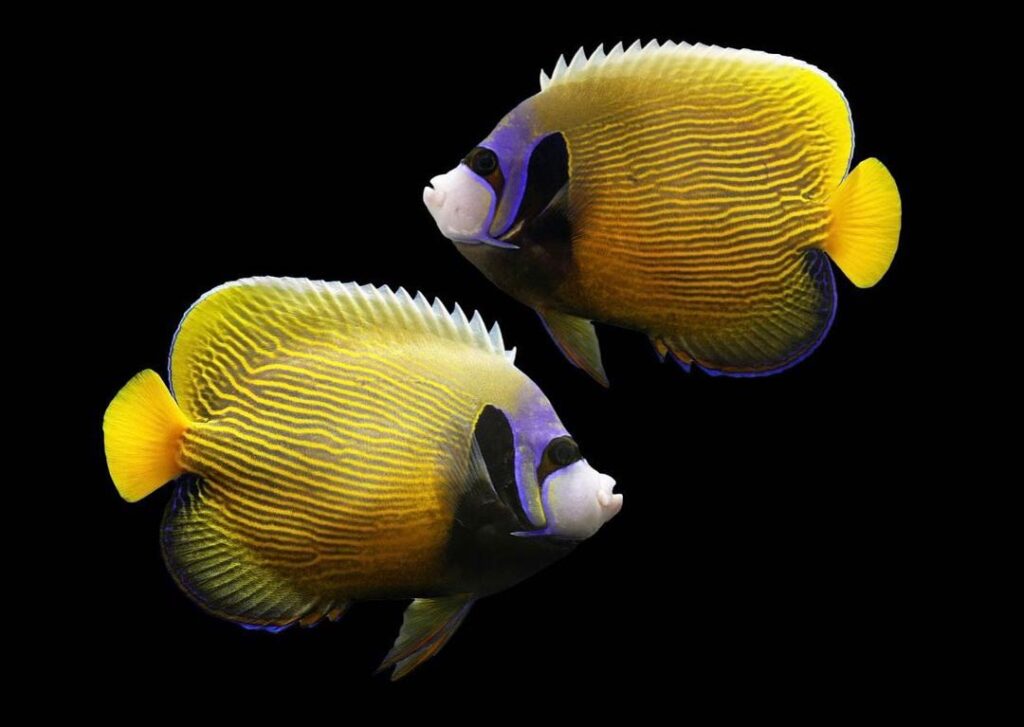
This week, Quality Marine unveiled the striking acquisition of an Emperor Angelfish unlike any seen prior. Fish like these are generally headed for one of only a few destinations. Many wind up in the hands of rare-fish collectors in Asia. If the fish is one that has a proven track record of captive-breeding, commercial aquaculture interests may clamor to obtain the specimen, in the hopes of obtaining distinctive genetic material that can lead to a new fish in the marketplace with no wild-caught counterpart. And, sometimes, a fish like this arrives in the U.S., destined for the aquarium of a well-funded aquarist that can appreciate, and afford, a one-of-a-kind specimen, being truly the embodiment of rarity.
We spoke with Quality Marine’s Kevin Kohen about this atypical Emperor Angelfish, to get a glimpse into the story of a rarity unlike any other.
“In my 40 years of working in the aquarium industry I have never seen an adult Emperor Angelfish with this aberration in person,” said Kohen. “From my research, the only documentation or photographs of an aberrant Emperor Angelfish (with a gold specking pattern as opposed to the very narrow, broken barred pattern down the length of the body) was back in 2014, brought to our attention by Yi Kai Tea in a blog post on the Reef Builders blog ( https://reefbuilders.com/2014/09/15/rare-fish-throwback-super-aberrant-hybrid-emperor-angelfish/ ).” The lack of any comparable fish ever being documented makes it truly a one-of-a-kind specimen.
Whether this fish represents a genetic abnormality, a fluke of nature, or a hybrid specimen, is up for debate. Kohen doesn’t believe that hybridization is at play here, but it was a hypothesis that had to be considered. Kohen shared that hybridization in the Pomacanthus angelfish is not exactly rare. “From time to time there has been infrequent documentation of hybridization in the wild of Pomacanthus angelfish in the Indian Ocean such as (P. imperator x P. chrysurus), (P. imperator x P. annularis), (P. imperator x P. maculosus), (P. chrysurus x P. semicirculatus), and (P. maculosus x P. semicirculatus). Additional hybridization in wild among Pomacanthus spp. angelfish in the Western Pacific and Indo-Pacific regions include (P. xanthometopon x P. sexstriatus), (P. navarchus x P. xanthometopon).”
“When this fish first arrived at Quality Marine, we spent time observing its body shape, colorations, and patterns to better determine if this angel is an aberrant or a hybrid. After much consideration and validating our observations with a well-respected taxonomist, we strongly believe this specimen is an aberrant Emperor Angelfish (Pomacanthus imperator) based on the body shape, coloration, and markings.”
Handling An Irreplaceable Fish
In some respects, while extremely rare, this fish was treated just like any other fish that arrives at Quality Marine. Thankfully, adult Emperor Angelfish are not unheard of in the aquarium trade and aren’t among the most challenging angelfish species to transition to captive life. While entirely relative, this specimen is probably a relatively “safe bet”.
Kohen explained how Quality Marine handles a fish like this. “Once fish arrive at our facility, they are carefully adjusted to our holding system’s water conditions and temperature. We then hold the specimens for observation and treatment if needed. The next process is to begin the transition process onto prepared foods. Nori sheets, along with offering Gamma frozen foods such as cockle, Mysis, and brine shrimp are offered to elicit a feeding response. Once the fish is actively feeding on frozen foods, we then transition them onto Nutramar dry foods, which include our all-natural Nutramar Complete Pellets and Nutramar Shots (soft foods). Once fully acclimated to captive conditions, and exhibiting normal behavior for the species, the fish is then purged, carefully packaged, and shipped to our valued store partner.”
And for those who simply must ask…
“Yes-the fish has been sold,” Kohen confirmed. While there’s no word on exactly where this fish will ultimately end up just yet, fish like this tend to be snatched up by retailers who have customers on the lookout for once-in-a-lifetime piscine opportunities.
So how much will an aquarist with deep pockets have to offer up to obtain a fish like this? It should come as no surprise that a wholesaler like Quality Marine has no say over what retailers charge, but Kohen was willing to at least proffer a general idea of what you might expect. “Although we don’t set retail price points, as you know, this spectacular fish should retail in the mid to upper 5-figure price range.”
Experience This Living Gem, Watch Now:




